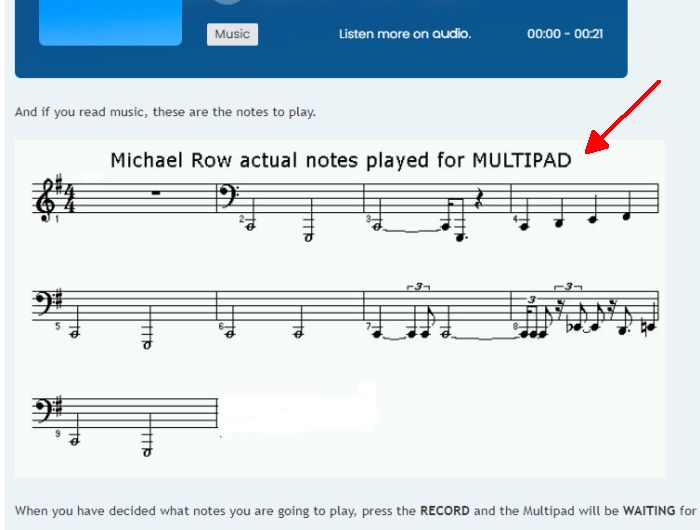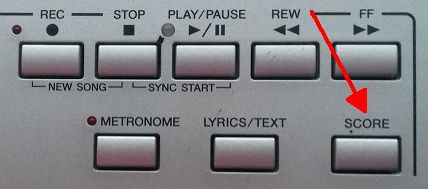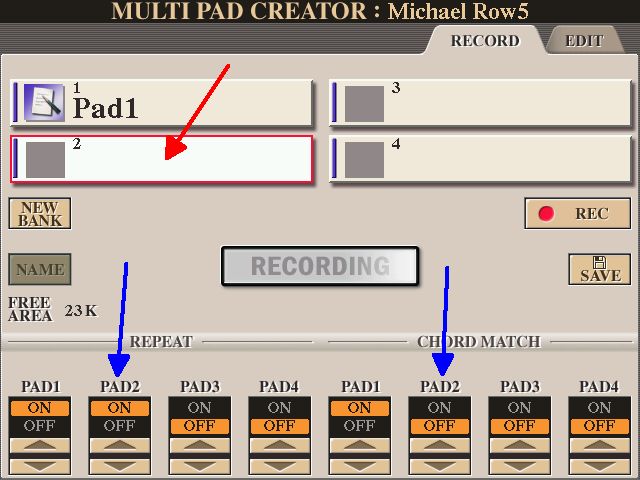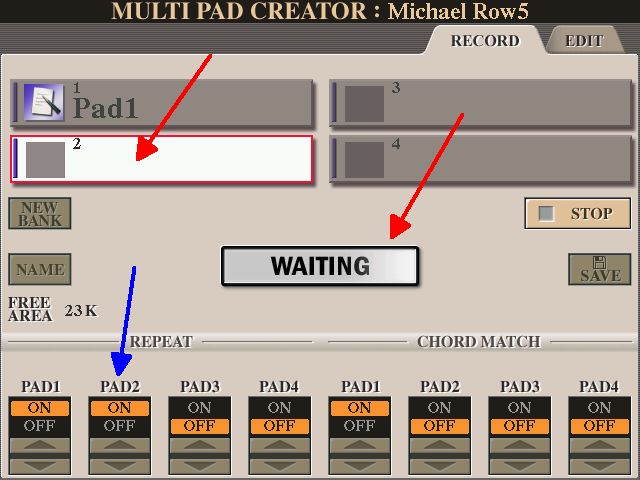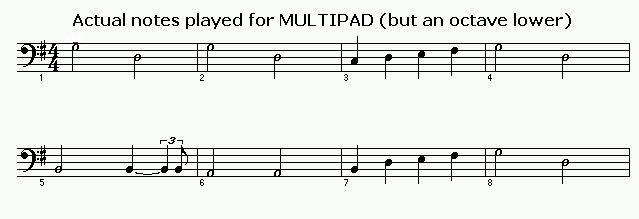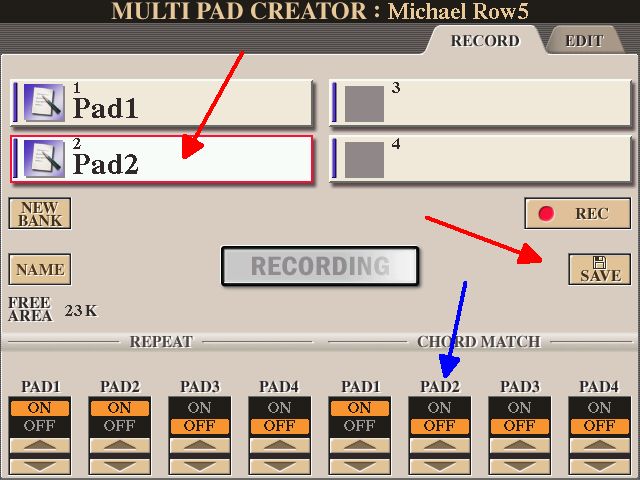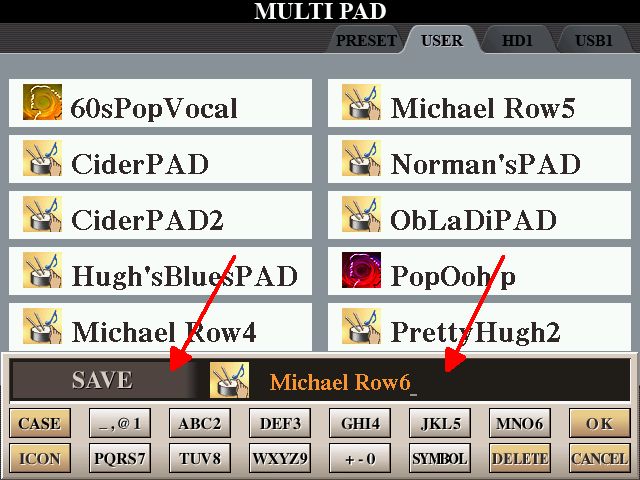One thought I had was that I have often used a MULTIPAD to add a 'counter melody' to a song I have been playing. So why not create a Multipad for the Bass Player? Here below is how I have done this.
When I create my MULTIPAD I need a VOICE set up in
R1. From the
BASS section I have chosen
LowBass (tossed between that and
AcousticBass).
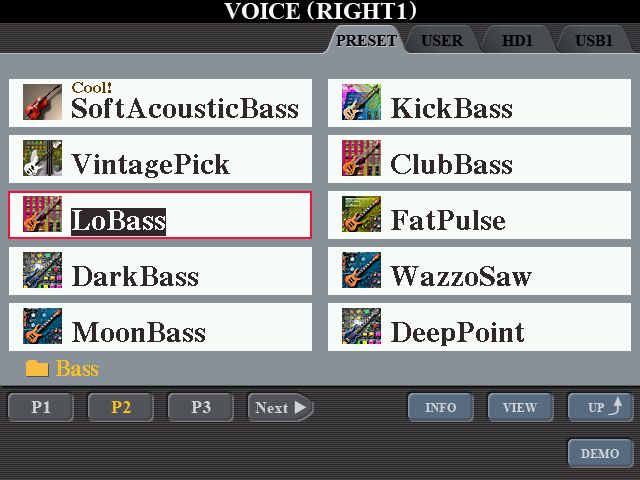
As I would be playing the bass notes with my right hand and not my left, I would want to play them in the region just below Middle C .. so I needed the VOICE to be an octave lower than it was. In the
MIXING CONSOLE, I dropped the R1 voice to -2.
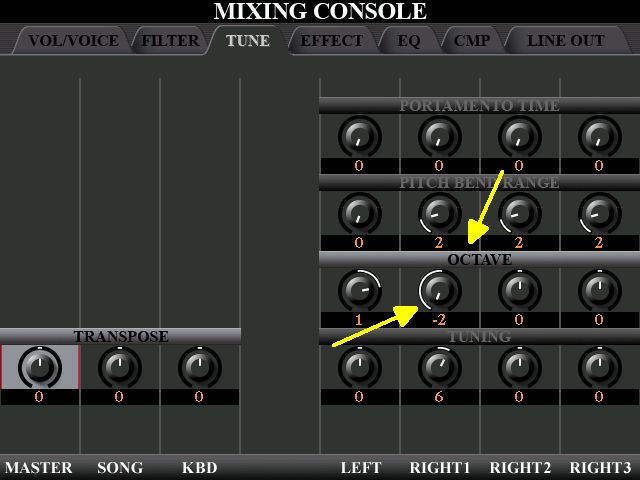
With all the other Multipads I have done, the notes I have played have all been to the right of the
Split Point. But playing a
BASS part? Would need to go below my split point. So have gone to the
Split Point page ...
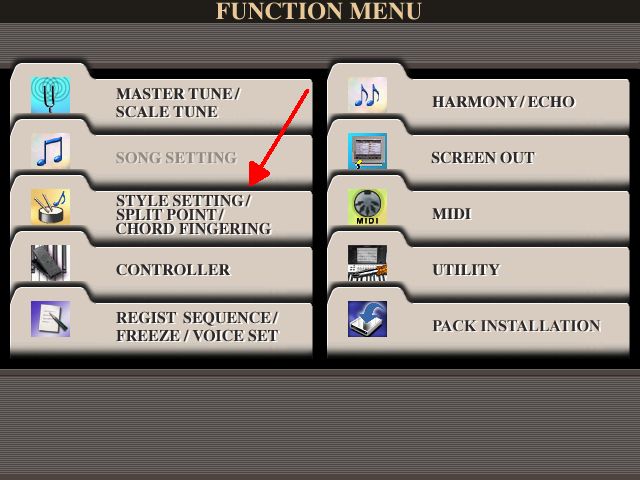
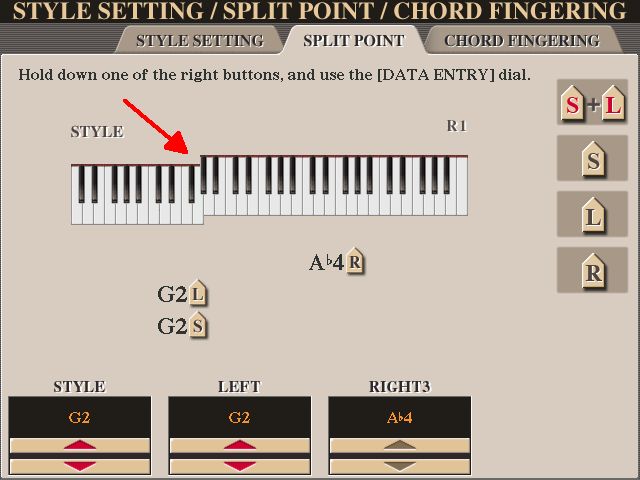
... and wound the black wheel round to the left until the Split Point was as far down as it would go.
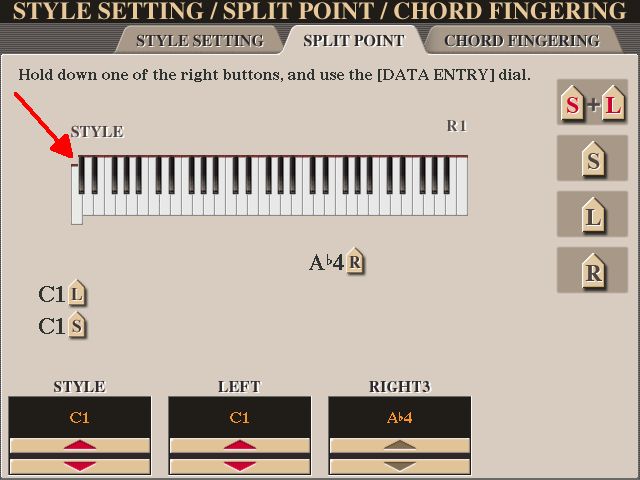
I then headed for the
MULTIPAD CREATOR page.
To get at the MULTI PAD screen, in the
MENU, choose
DIGITAL RECORDING ...
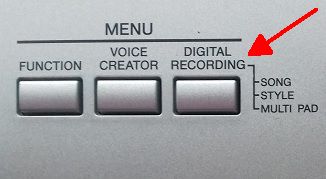
... and then choose
MULTI PAD CREATOR.
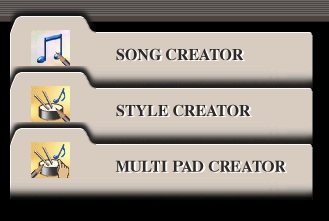
The screen you get has to be set up for the type of MULTIPAD you want to create. You can create four different Multipads for the song you are playing and can trigger which one/ones you want when you want it/them. In this example I am only making
one Multipad, so I am making my choices for
PAD1.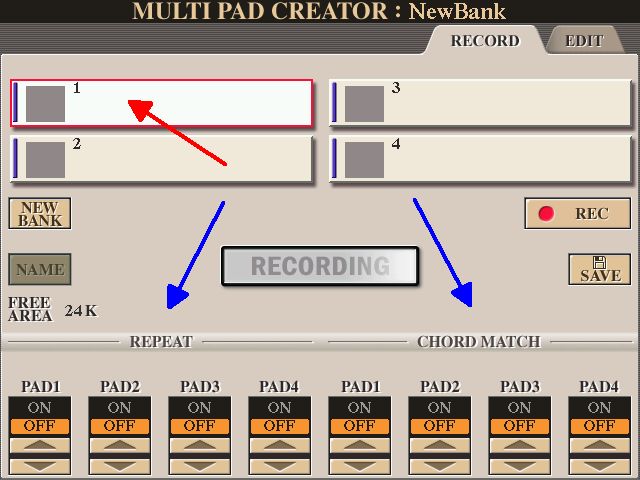 There are two ways you can set up a MULTIPAD. 1.
There are two ways you can set up a MULTIPAD. 1. You can record some notes, and when you trigger the MULTIPAD when playing your song the Multipad will play those notes back at you exactly as you played them. For this DEMO I will be playing
Michael Row The Boat Ashore in G, so if doing it this way I would have to play the bass notes I want to hear in the key of G.
Note: Creating a Multipad is not like putting in a PART in a STYLE. A STYLE 'repeats' the pattern according to the 'measure' of the Style (ie. how many bars elapse before the pattern repeats itself). With a MULTIPAD you play notes to follow the
melody, so can put notes in for a
whole verse. Any REPEAT will take place when playing a second verse .. and if you don't want it doing that (eg. because you are playing the CHORUS next) you will have to turn the MULTIPAD
OFF.
If you click the play arrow below you can listen to the bass notes I want (in G).
If you read music, these are the notes to play.
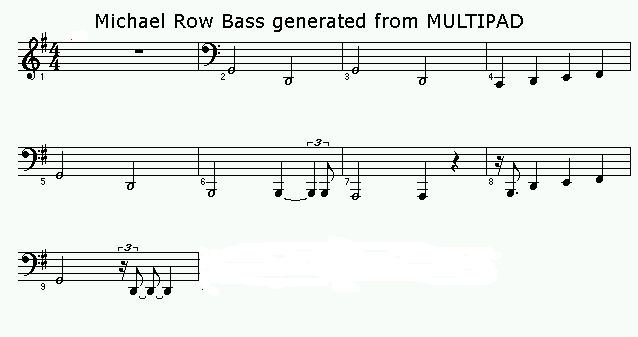
Of course doing it this way the MULTIPAD can
only be used when the piece is being played in the key of G. I shall be doing
my BASS part with the
CHORD MATCH ON .. then the Multipad can be used when playing the song in
any key.
2. The second way of doing a MULTIPAD is to have the
CHORD MATCH ON, and then you have to record all your notes in C (ie. with C as the ROOT).
CHORD MATCH means that it will play 'intervals' based on the root of the chord you are playing. You have to RECORD everything with C as the root. To get the MULTIPAD to play specific notes, you have to work out the interval relative to the chord you are playing at that point (sorry, it's getting complicated now). So, for example, if at a certain point in the song you were playing the chord of
F and wanted the bass to 'walk up'
F,
G,
A, to
Bb (and at that point were playing a Bb chord) .. the actual notes you would play for your MULTIPAD (based on
C as the root) would be
C,
D,
E,
C. This 'walking up' from C would actually be 'walking up' from F, as that is the chord you will be playing. And yes, that last note you have to record as a
C because at that point you have just walked up from F and are playing a Bb chord, and the Bb you want to hear is the
root of the chord you are playing. In the key of
C,
C is the root. So you record the note C.
I have set up the options as below (arrowed
blue).
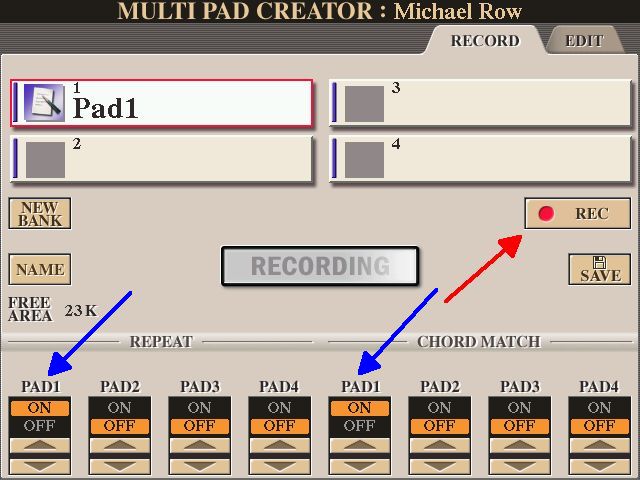 REPEAT
REPEAT means it will
repeat the notes you program in.
But note ... the REPEAT is not like a STYLE, which repeats every 'Measure'. The MULTIPAD 'repeats' whatever you program in .. which can be for a whole verse (and that is what I shall be doing here) .. so I don't even have to think about what the STYLE is doing .. only what the
melody is doing.
I have worked out all the 'intervals' in the DEMO above relative to the actual chords I play in the song, and transferred these to intervals with
C as the ROOT. You can hear what these notes are (when playing them with C as the 'root') by clicking the play arrow below.
And if you read music, these are the notes to play.
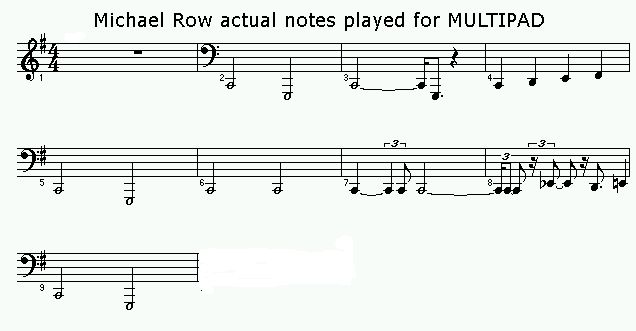
When you have decided what notes you are going to play, press the
RECORD and the Multipad will be
WAITING for you to start the recording.
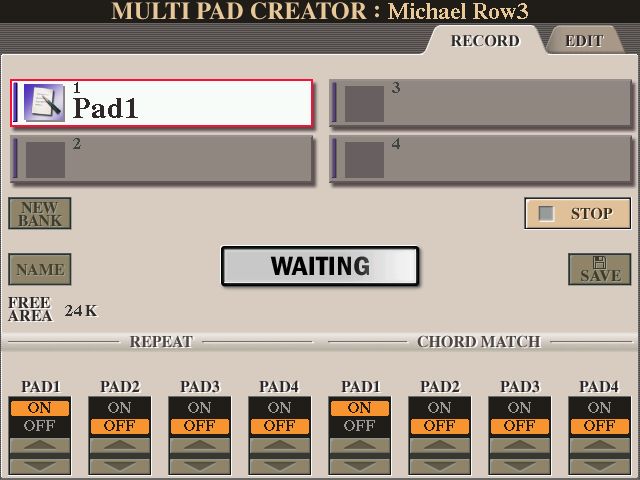
ie. WAITING for you to press a note to start the recording.
START THE METRONOME GOING .. then you will be able to keep time with your recording, The louder 'clang' is on the first beat of the bar.
If you want to start recording
on the first beat of the bar, then press the
SYNC START (so it's flashing). It'll then still be
WAITING for you to press that first note. Do that when you hear the Metronome 'clang' on the first beat of the bar.
If you want to start playing notes
after the first beat of the bar, then press the
START on the first beat of the bar and come in with playing notes where you want to hear them.
Next question. When do you STOP the MULTIPAD? Answer: At the end of the bar at the end of the verse. Then the REPEAT will start on the first beat of the
next verse. You STOP it by pressing the
STOP showing on the screen; or the
START/STOP button by the SYNC START.
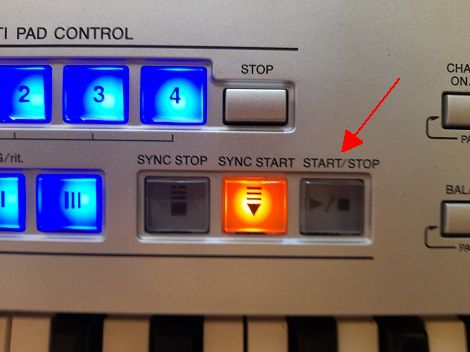
You then have to
SAVE the MULTIPAD you have created (give it a
NAME).
When using this MULTIPAD BASS you have just created you have to set up your STYLE
with the BASS PART turned OFF .. otherwise you will get the standard 'default' Yamaha bass part playing along with your Multipad.
And how does all this sound with the MULTIPAD replacing the 'default' Yamaha BASS?
Click the play arrow below to listen.
As a piece of music, I'd much rather listen to that, with the bass part tailored to the melody, than the version with the 'default' Yamaha bass you heard in the start of my topic.
If there are any questions about all this, please do ask.
Hugh


 ..
.. 













